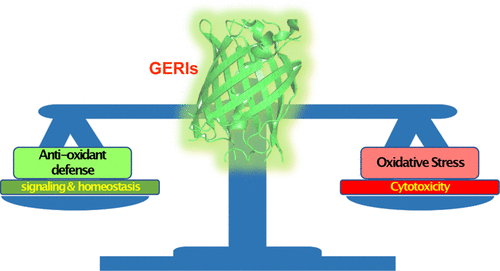当前位置:
X-MOL 学术
›
Chem. Res. Toxicol.
›
论文详情
Our official English website, www.x-mol.net, welcomes your
feedback! (Note: you will need to create a separate account there.)
Genetically Encoded Fluorescent Redox Indicators for Unveiling Redox Signaling and Oxidative Toxicity
Chemical Research in Toxicology ( IF 3.7 ) Pub Date : 2021-07-20 , DOI: 10.1021/acs.chemrestox.1c00149 Yu Pang 1, 2 , Hao Zhang 1, 2 , Hui-Wang Ai 1, 2, 3, 4
Chemical Research in Toxicology ( IF 3.7 ) Pub Date : 2021-07-20 , DOI: 10.1021/acs.chemrestox.1c00149 Yu Pang 1, 2 , Hao Zhang 1, 2 , Hui-Wang Ai 1, 2, 3, 4
Affiliation

|
Redox-active molecules play essential roles in cell homeostasis, signaling, and other biological processes. Dysregulation of redox signaling can lead to toxic effects and subsequently cause diseases. Therefore, real-time tracking of specific redox-signaling molecules in live cells would be critical for deciphering their functional roles in pathophysiology. Fluorescent protein (FP)-based genetically encoded redox indicators (GERIs) have emerged as valuable tools for monitoring the redox states of various redox-active molecules from subcellular compartments to live organisms. In the first section of this review, we overview the background, focusing on the sensing mechanisms of various GERIs. Next, we review a list of selected GERIs according to their analytical targets and discuss their key biophysical and biochemical properties. In the third section, we provide several examples which applied GERIs to understanding redox signaling and oxidative toxicology in pathophysiological processes. Lastly, a summary and outlook section is included.
中文翻译:

用于揭示氧化还原信号和氧化毒性的基因编码荧光氧化还原指示剂
氧化还原活性分子在细胞稳态、信号传导和其他生物过程中发挥重要作用。氧化还原信号的失调会导致毒性作用并随后引起疾病。因此,实时跟踪活细胞中特定的氧化还原信号分子对于破译它们在病理生理学中的功能作用至关重要。基于荧光蛋白 (FP) 的基因编码氧化还原指示剂 (GERI) 已成为监测从亚细胞区室到活生物体的各种氧化还原活性分子的氧化还原状态的宝贵工具。在本综述的第一部分,我们概述了背景,重点关注各种 GERI 的传感机制。接下来,我们根据分析目标审查选定的 GERI 列表,并讨论它们的关键生物物理和生化特性。在第三部分中,我们提供了几个应用 GERI 来理解病理生理过程中的氧化还原信号和氧化毒理学的例子。最后,包括总结和展望部分。
更新日期:2021-08-16
中文翻译:

用于揭示氧化还原信号和氧化毒性的基因编码荧光氧化还原指示剂
氧化还原活性分子在细胞稳态、信号传导和其他生物过程中发挥重要作用。氧化还原信号的失调会导致毒性作用并随后引起疾病。因此,实时跟踪活细胞中特定的氧化还原信号分子对于破译它们在病理生理学中的功能作用至关重要。基于荧光蛋白 (FP) 的基因编码氧化还原指示剂 (GERI) 已成为监测从亚细胞区室到活生物体的各种氧化还原活性分子的氧化还原状态的宝贵工具。在本综述的第一部分,我们概述了背景,重点关注各种 GERI 的传感机制。接下来,我们根据分析目标审查选定的 GERI 列表,并讨论它们的关键生物物理和生化特性。在第三部分中,我们提供了几个应用 GERI 来理解病理生理过程中的氧化还原信号和氧化毒理学的例子。最后,包括总结和展望部分。











































 京公网安备 11010802027423号
京公网安备 11010802027423号